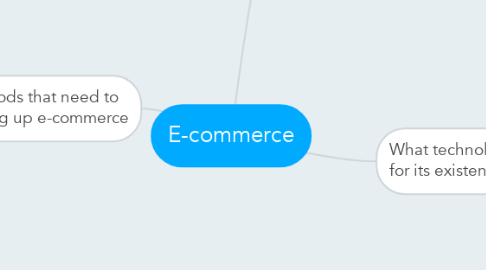
1. Risks and prevention methods that need to be considered when setting up e-commerce
1.1. Hacking
1.1.1. A hacker is someone who seeks and exploits weaknesses in a computer system or computer network. These need to be considered as if they manage to hack your system critical information could be stolen for example bank information .
1.2. Viruses
1.2.1. A computer virus is a malware program that when executed replicates itself and inserts itself into other computer programs, data files and the boot sector of the hard drive. Viruses need to be considered a risk as if the server gets a virus it could bring down the entire computer server.
1.3. Identity Theft
1.3.1. Identity theft is a form of stealing someone else's identity this needs to be considered a risk as conducting business over the internet you could not be familiar with the person you are dealing with which means they could be trying to gain information or steal resources while pretending to be someone else.
1.4. HTTPS
1.4.1. HTTPS (Hypertext transfer protocol secure) is a prevention method it is a communications protocol for secure communication over a computer network.
1.5. Strong Password's are a necessity when setting up e-commerce as this makes it harder for hackers to get into the system, strong passwords usually include capital letters and numbers or symbols
1.6. Alternative authentication methods help to protect the system as it will implement some other form of authentication along with the username and password for example security questions which you know the answer to as you entered the answer for the question when setting them up
1.7. A firewall is a network security system that controls the incoming and outgoing network traffic based on applied rule set. This is useful as it allows you to control what comes in and out of your network this is usually used to prevent hacking and viruses.
2. What is e-commerce
2.1. E-commerce is trading products or services over computer networks such as the internet
3. What technologies are required for its existence and use
3.1. Programming languages
3.1.1. Html is a standard programming language to create web pagwa
3.1.2. XHTML is an extended version of HTML
3.1.3. PHP is a server side scripting language which is used for website development
3.1.4. ASP is Microsoft's first server side scripting engine for dynamically generate web pages
3.1.5. JavaScript is a dynamic computer programming languages and it allows scripts to interact with the user
3.2. Web server, browser and server software
3.2.1. A web browser is used to retrieve information resources from the web it changes information so that the user can view it. Internet browsers also renders the page so it can be viewed it takes keywords to search the internet. Server software is software designed to be used and managed on a computer server.
3.3. Web authoring software
3.3.1. This is a type of software used to develop a website in a desktop publishing format. The software creates the required HTML code for the layout of the web.
3.4. Database systems
3.4.1. Database systems are a series of programs that can store, modify and extract information from a database.
3.5. TCP/IP addresses
3.5.1. TCP stands for transmission control protocol and is the higher layer of the OSI module
3.5.2. IP is the lower layer of the OSI module and manages the packets sent.
3.6. Ports and protcols
3.6.1. Ports connect IP's and protocols together, ports are between the computer and the network.
3.6.2. Protocol is a standard of the way that the computer are linked
3.7. Domain names
3.7.1. A domain name allows users to create a website as it identifies 1 or more ip addresses
